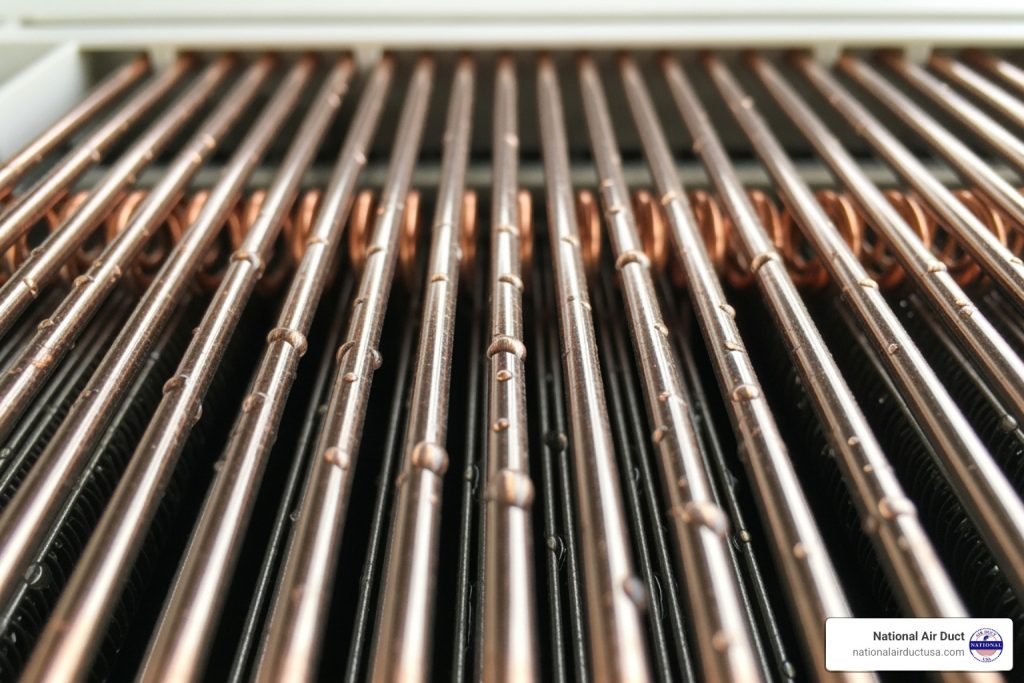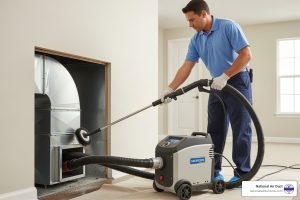Why Clean Window AC Coils Matter for Your Home
How to clean window unit air conditioner coils is a crucial skill every homeowner should master. Here’s the quick answer:
Quick Steps:
- Unplug the unit and remove the front panel
- Vacuum loose debris from coils using a soft brush attachment
- Spray coil cleaner on evaporator and condenser coils
- Let sit for 10-15 minutes, then rinse with water (for deep clean)
- Straighten bent fins with a fin comb
- Dry completely before reassembling
Your window AC unit works hard to keep your family comfortable, but dirty coils can sabotage everything. When dust, debris, and grime build up on those delicate metal fins, your unit has to work up to 30% harder to cool your home – and that shows up fast on your electricity bill.
But it’s not just about money. Dirty coils create the perfect breeding ground for mold and bacteria that get pumped straight into your living space. For New York families dealing with high humidity and urban air quality challenges, this becomes a serious health concern.
The good news? Regular coil cleaning can cut your energy bills by 20-30% while dramatically improving your indoor air quality. Your AC will cool faster, run quieter, and last years longer.
Whether you choose the quick “lazy” method or go for a complete deep clean, this guide will walk you through both approaches step-by-step.
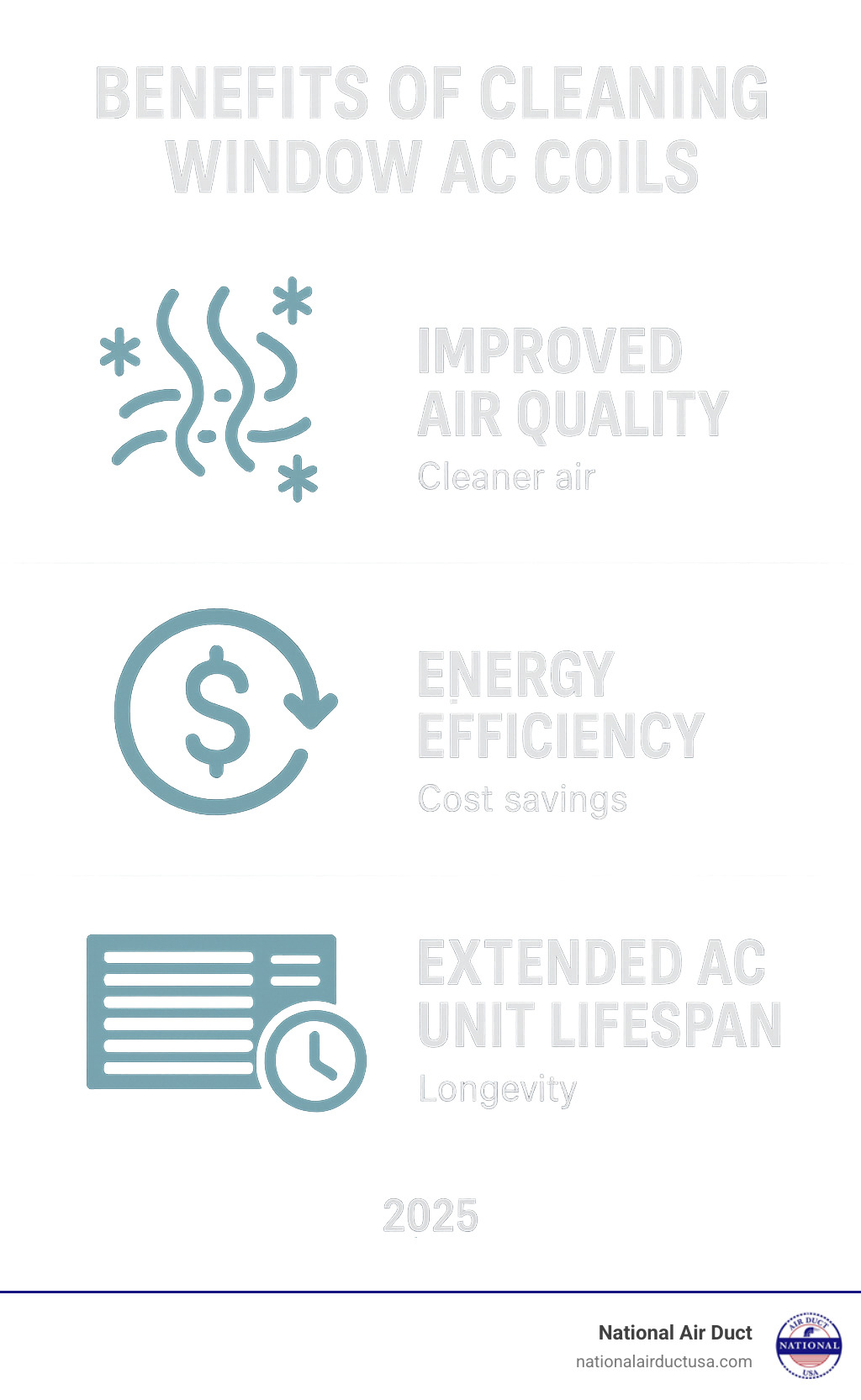
Preparing for the Clean: What You Need and When to Do It
Your window AC has been working hard all season, but lately, something feels off. Maybe your bedroom isn’t getting as cool as it used to, or there’s a funky, musty smell every time the unit kicks on. These are your AC’s way of saying “Help! My coils need cleaning!”
Dirty coils show themselves in pretty obvious ways. You might notice reduced cooling power – your unit runs constantly but never quite reaches that perfect temperature. That musty odor we mentioned? That’s often mold and bacteria having a party on your grimy coils. And if you can actually see dust and debris caked on the metal fins, it’s definitely time to act.
Here’s the kicker: dirty coils can bump up your energy bills by 30% or more. Your poor AC has to work overtime just to do its basic job, and you’re paying for every extra watt.
Don’t worry though – learning how to clean window unit air conditioner coils is totally doable for most homeowners. And if you’d rather leave it to the pros, you can find more info about our Unit Cleaning services right here.
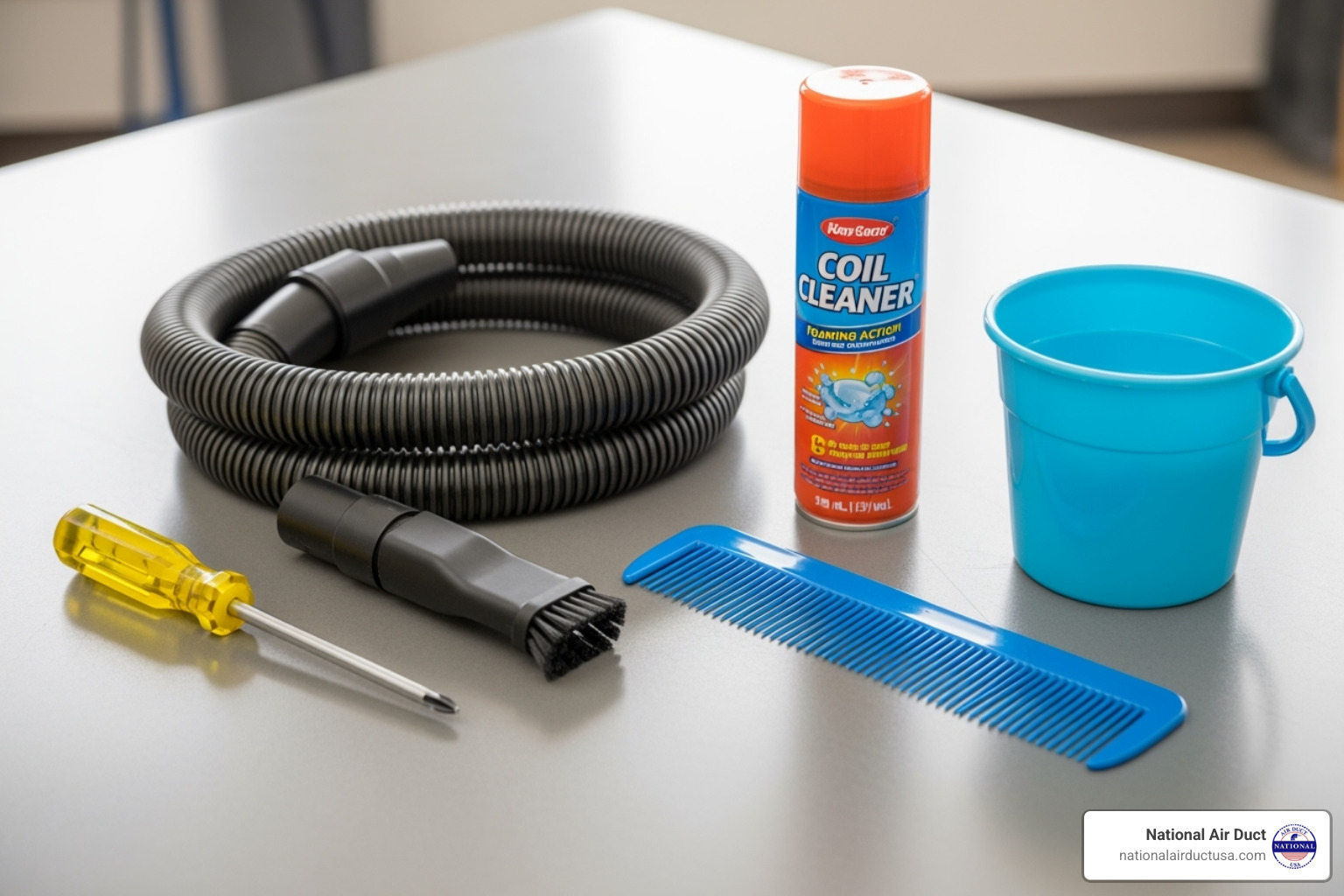
Essential Tools and Materials
Getting organized before you start makes everything smoother. Think of it like cooking – you want all your ingredients ready before you turn on the stove.
You’ll need a screwdriver to remove panels and access those hidden coils. A vacuum with a brush attachment is perfect for gently sucking up loose debris without bending those delicate fins. Grab a soft-bristle brush (an old toothbrush works great for tight spots) to coax stubborn dirt loose.
For deeper cleaning, you’ll want a garden hose for rinsing. Protective gloves keep your hands clean and safe from cleaning chemicals, while safety glasses protect your eyes from flying debris and cleaner splashes.
Here’s a tool many people don’t know about: a fin comb. This handy gadget straightens bent coil fins to restore proper airflow. No fin comb? A credit card can work in a pinch.
You’ll also need commercial coil cleaner (we’ll talk about types in a minute), mild dish soap for general cleaning, a bucket for mixing solutions, and plenty of towels for wiping and drying everything down.
Choosing a Coil Cleaner: Foaming vs. Non-Foaming
Walk down the cleaning aisle and you’ll see two main types of coil cleaners: foaming and non-foaming. Each has its place, depending on how dirty your coils are.
| Coil Cleaner Type | Pros | Cons |
|---|---|---|
| Foaming | Deep penetration for tough dirt, less scrubbing needed | Can be messy, requires thorough rinsing |
| Non-Foaming | Easier to rinse, less residue, gentler on coils | May need more scrubbing for stubborn grime |
Foaming cleaners are like the heavy artillery – they expand into every nook and cranny, breaking down years of built-up grime. They’re great for really dirty coils but can get a bit messy.
Non-foaming cleaners are gentler and easier to control. They won’t corrode aluminum fins as easily, but you might need to put in a little more elbow grease.
Whatever you choose, avoid harsh chemicals like bleach or vinegar – they can eat away at your coils over time.
How Often Should You Clean Your Coils?
Here’s the honest truth: most people wait way too long between cleanings. The U.S. Department of Energy recommends cleaning or replacing filters monthly during heavy use, but coils need attention too.
Plan for an annual deep cleaning before cooling season starts. This ensures your unit is ready when that first heat wave hits. If you’re using your AC daily during summer, your monthly filter cleaning routine should also include a quick coil inspection.
Some situations call for more frequent attention. Live in a dusty area or have pets that shed? You might need to clean every three to six months. Same goes for high-pollen areas – all that outdoor stuff gets sucked right into your unit.
The good news is that once you know how to clean window unit air conditioner coils, the whole process becomes second nature. Your wallet and your comfort will thank you for staying on top of it.
Your Step-by-Step Guide on How to Clean Window Unit Air Conditioner Coils
Alright, it’s time to roll up our sleeves and get to work! But before we dive in, let’s talk about the most important part of this entire process: safety first.
I cannot stress this enough – always unplug your unit before you even think about touching anything. We’re dealing with electricity and water here, which is never a good combination. Those delicate metal fins can also be surprisingly sharp, so take your time and be gentle. And if you’re using any cleaning solutions, make sure you’ve got good ventilation going – your lungs will thank you later.
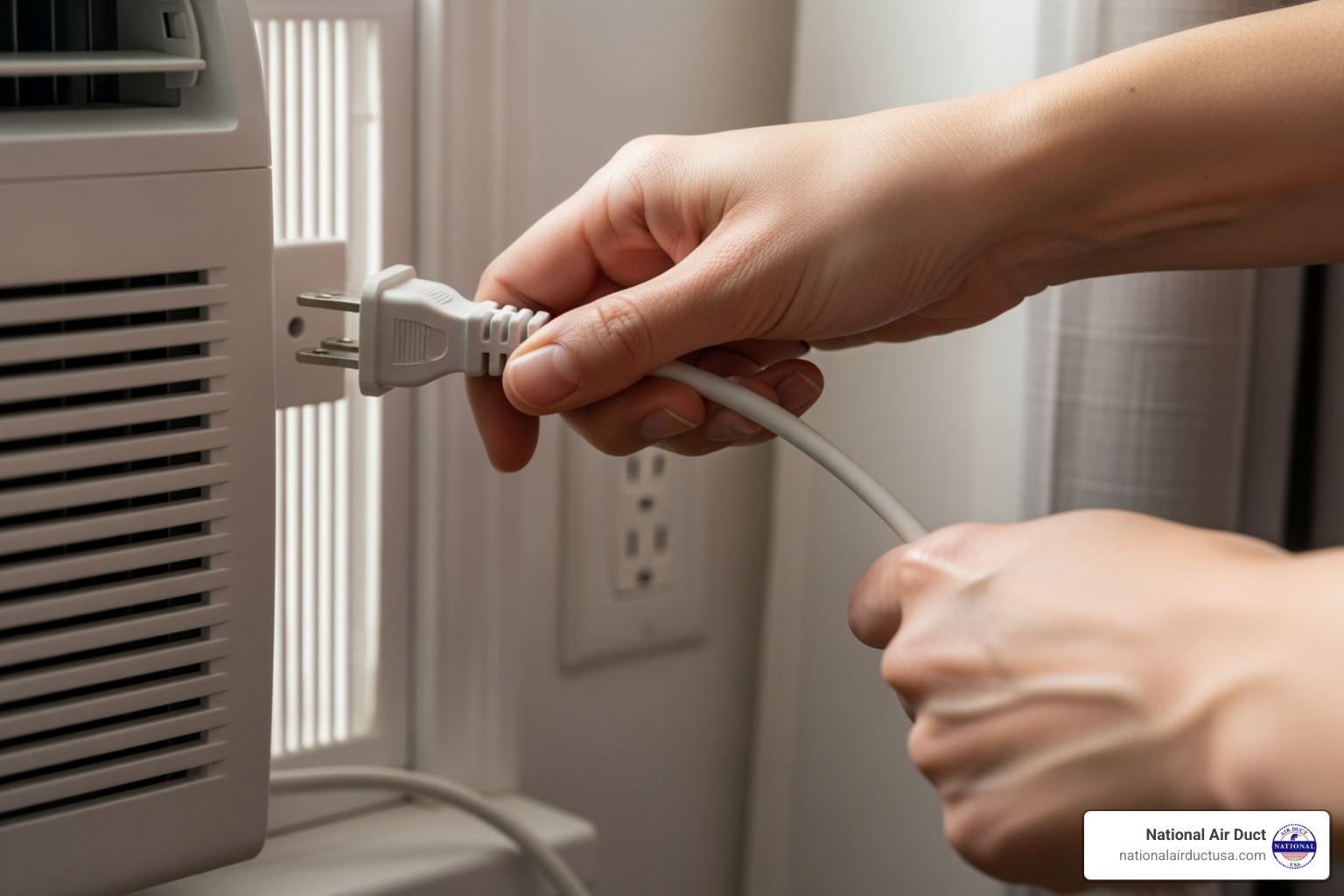
The ‘Lazy’ Method: How to clean window unit air conditioner coils without removing the unit
Let’s be honest – sometimes you just want to get the job done without turning it into a weekend project. This method is perfect for regular maintenance when your unit isn’t completely gunked up, and you’d rather not wrestle it out of the window.
Start with the basics. Turn off your unit at the control panel, then unplug it from the wall. If it’s hardwired (which is less common), flip the circuit breaker. I know I keep harping on this, but it’s really that important.
Getting inside is easier than you think. Most window units are designed to be cleaned in place. Gently remove the front grille – some have clips, others need a screwdriver. Don’t force anything. Once that’s off, carefully slide out the air filter. This little guy is your first line of defense against dust and debris.
Your filter needs some TLC too. Give it a good vacuum first to get the loose stuff off. Then wash it thoroughly with warm, soapy water. If you’re dealing with mold or it’s really grimy, you can soak it in a weak bleach solution (1 part bleach to 10 parts water) for about 10 minutes, then rinse it completely. The key here is letting it dry completely before putting it back – a damp filter is like rolling out the red carpet for mold.
Now for the main event – the coils. With the front panel removed, you’ll see those silvery metal fins (the evaporator coils). They’re delicate, so be gentle. Use your vacuum with the soft brush attachment to remove loose dust, pet hair, and whatever else has decided to make itself at home in there.
Time for the cleaning solution. Mix up some mild dish soap and water in a spray bottle, or use a non-foaming coil cleaner if you’ve got one. Lightly mist the coils and surrounding areas, but avoid any electrical components like they’re the plague. Let it sit for a few minutes to work its magic.
The final touches. Use a damp cloth to gently wipe down the coils and interior surfaces. You might not see dramatic runoff like you would with a deep clean, but you’re removing that surface grime that’s been making your unit work harder. Make sure everything’s as dry as possible before you start putting things back together.
Wrap it up. Give that front grille a good wash with warm, soapy water, rinse it well, and let it dry. Once your filter is bone dry, slide it back in and reattach the front panel. You’re done!
The Deep Clean: A thorough guide on how to clean window unit air conditioner coils
When your how to clean window unit air conditioner coils project calls for the heavy artillery, this is your method. Maybe it’s been a while since the last cleaning, or you’re battling some serious grime. Either way, we’re going all out.
This means taking the unit out. After unplugging (seriously, I’ll keep saying it), you’ll need to carefully remove the entire unit from the window. These things are heavier than they look, so grab a friend to help, especially if you’re dealing with stairs or upper floors.
Find yourself a good outdoor workspace. A patio, garage, or driveway works perfectly. You’ll be using water, so pick somewhere that can handle a bit of mess. This is also where those old towels will come in handy.
Time to play mechanic. You’ll need to remove the outer casing to access both sets of coils – the evaporator coils you see from the front, and the condenser coils that face outside. This usually means unscrewing several screws. Here’s a pro tip: take photos as you go. Trust me, you’ll thank yourself later when you’re trying to remember how everything fits back together.
Start with the filter and grille. Follow the same process from the lazy method – vacuum, wash with soap and water (or that bleach solution for stubborn mold), rinse thoroughly, and let air dry completely.
The evaporator coils get the VIP treatment. First, vacuum away any loose debris with your brush attachment. Then apply your coil cleaner generously – foaming or non-foaming, whatever you’ve chosen. Make sure you get even coverage and follow the product’s instructions for how long to let it sit (usually 10-15 minutes). If you’re using a foaming cleaner, it often does the work for you as it expands into all those little crevices.
Rinse like you mean it. Use a gentle stream from your garden hose to rinse the coils thoroughly. The trick is to spray from the inside out – this pushes dirt and cleaner through the fins instead of deeper into them. Just be careful not to soak any electrical components.
Don’t forget the outside coils. The condenser coils face the elements and often look like they’ve been through a war. Remove any large debris by hand first – leaves, twigs, whatever nature has thrown at them. Vacuum or brush away loose dirt, apply your cleaner, let it work, then rinse thoroughly from the inside out.
The drain pan deserves attention too. This little tray under the evaporator coils catches condensation, and it can become a swamp of mold and sludge. Empty it out and scrub it clean with warm, soapy water. For persistent mold, that mild bleach solution works wonders. While you’re at it, wipe down the fan blades with a damp cloth.
Here’s where the fin comb shines. After all that cleaning, take a look at your coils for bent fins. These thin metal plates are crucial for heat transfer, and bent ones restrict airflow. Gently use your fin comb to straighten them out. It’s oddly satisfying and really does help your unit perform better.

Patience is key for drying. This is absolutely critical – everything needs to be completely dry before reassembly. We’re talking several hours, maybe even overnight in a well-ventilated area. You can use a fan to speed things up, but don’t rush this step. Moisture trapped in your unit is an invitation for mold and electrical problems.
Put it all back together. Reverse your disassembly steps, making sure all screws are secure and everything’s in its proper place. Carefully reinstall the unit in your window, plug it back in, and fire it up.
Enjoy the results. You should immediately notice better cooling, improved airflow, and fresher air. Your electric bill will thank you too – a clean unit can be up to 30% more efficient than a dirty one.
Maintaining Your Clean Coils and Knowing When to Call a Pro
Congratulations! You’ve successfully learned how to clean window unit air conditioner coils and put in the hard work to get them sparkling clean. Now comes the fun part – keeping them that way with some smart maintenance habits.
Think of coil maintenance like brushing your teeth. A little effort every day prevents big problems down the road. Regular inspections can catch small issues before they turn into expensive headaches, and a few simple habits will keep your freshly cleaned coils performing like champions.
For those times when you need more comprehensive cleaning beyond what DIY can handle – especially internal components and ductwork – professional services can make all the difference. You can find More info about professional Coil Cleaning if you’d prefer the peace of mind that comes with expert care.
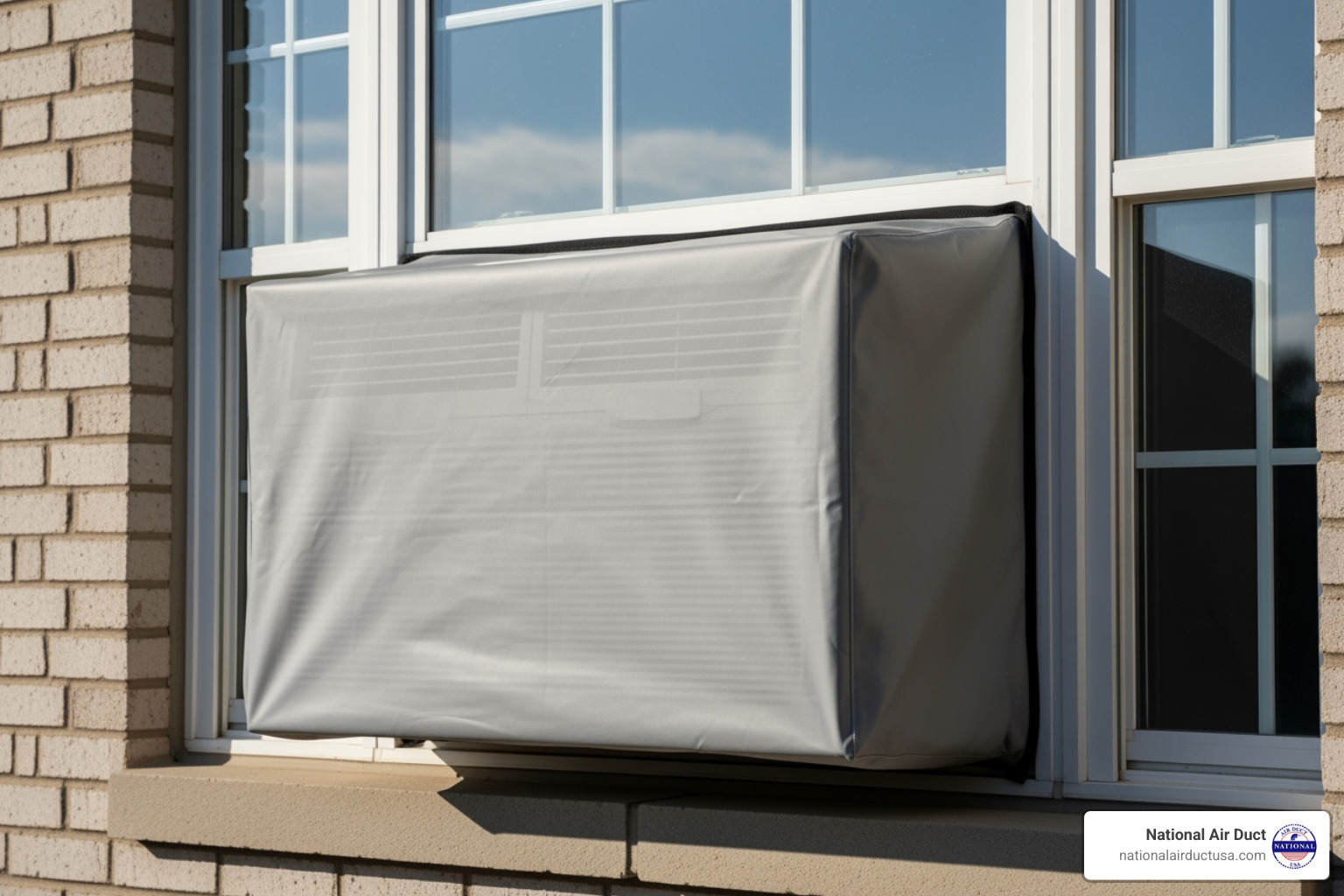
Tips for Keeping Coils Cleaner for Longer
Your filter is your coils’ best friend. Clean your reusable filter monthly and replace disposable ones every 1-3 months. This simple step prevents dust and debris from reaching the coils in the first place – it’s like having a bouncer at the door of your AC unit.
When winter arrives and your window AC takes a well-deserved break, cover it with a protective AC unit cover. This keeps dust, dirt, curious insects, and moisture from setting up camp inside your unit. Your future self will thank you when spring cleaning becomes a breeze.
Seal those window gaps around your unit to create an airtight barrier. Loose seals are like leaving your front door cracked open – they invite outside air, pollen, and dust to sneak in and dirty up your clean coils.
Running an air purifier in the same room as your window AC creates a tag-team effect. The purifier captures airborne particles before they reach your AC’s filter, reducing the workload on both systems.
For an extra layer of protection, some homeowners lightly mist their coils with a 3% hydrogen peroxide solution occasionally (with proper ventilation and eye protection). Its natural antifungal properties help discourage mold growth. Just make sure everything air dries completely afterward.
When DIY Isn’t Enough: Calling a Professional
While we’ve armed you with everything you need to know about how to clean window unit air conditioner coils, sometimes it’s best to wave the white flag and call in the experts. Here’s when DIY reaches its limits.
Significant mold growth that won’t budge despite your best efforts needs professional attention. If you’re seeing extensive or deeply embedded mold, or suspect it has spread beyond what you can reach, specialized equipment and expertise are required. Mold spores can be serious business for your health.
Any electrical issues – strange noises, blown fuses, or electrical malfunctions – are a definite no-go for DIY repairs. Electricity and water don’t play nice together, and professional HVAC technicians have the training to handle these situations safely.
Refrigerant leaks are another job for the pros. If you notice ice formation on your coils after cleaning, or your unit is blowing warm air despite being spotless, you might have a leak. Refrigerant requires certified technicians who know how to handle these chemicals safely.
Severely damaged coils – bent beyond repair, corroded, or full of holes – may be beyond what a fin comb can fix. These issues significantly impact efficiency and can lead to bigger system failures if ignored.
If your unit still isn’t cooling after you’ve followed all our cleaning steps, there’s likely an underlying mechanical issue hiding somewhere. Compressor problems, fan motor issues, or unusual noises like ticking sounds often signal problems that need professional diagnosis.
For complex issues or when you want the confidence that comes with professional service, our team is ready to help. We provide More info about our HVAC Repair services for homeowners who want expert care for their cooling systems.
Frequently Asked Questions about Window AC Coil Cleaning
After helping thousands of New York homeowners with their AC units, we’ve heard just about every question imaginable about how to clean window unit air conditioner coils. Let’s tackle the most common concerns that keep popping up in our inbox.
What are the biggest mistakes to avoid when cleaning AC coils?
We’ve seen some real horror stories over the years, and honestly, most could have been avoided with just a little know-how. The biggest mistake we see? Using high-pressure water like you’re washing your car. Those delicate aluminum fins weren’t designed for that kind of treatment – they’ll bend faster than you can say “oops,” and suddenly your airflow is restricted.
Bending the fins is another heartbreaker we see all the time. Whether it’s from aggressive vacuuming or trying to scrub too hard, bent fins are like putting a kink in a garden hose – the air just can’t flow properly anymore. That’s exactly why we recommend having a fin comb handy.
Here’s one that makes us cringe every time: getting electrical parts wet. Water and electricity are never friends, and your AC unit has plenty of both. Always keep your spray away from wiring, control panels, and any electrical components.
We also see folks reaching for whatever’s under the kitchen sink, but using harsh chemicals not designed for coils can actually eat away at the metal over time. Your coils are more delicate than they look, so stick with products made specifically for them or simple dish soap.
And please, please remember to unplug the unit first. We can’t stress this enough – it’s the difference between a successful DIY project and a trip to the emergency room.
Can I use vinegar or bleach to clean my AC coils?
This question comes up constantly, and we get why – vinegar and bleach seem like natural go-to cleaners. But here’s the thing: your AC coils are usually made of aluminum or have copper components, and both vinegar and bleach can be pretty harsh on these metals.
Bleach is particularly aggressive and can actually corrode your coils over time, leading to tiny holes and refrigerant leaks that’ll cost you way more than a bottle of proper coil cleaner ever would. Vinegar’s acidity can also gradually weaken aluminum fins, making them more prone to damage.
Most manufacturers specifically warn against these household cleaners in their manuals for good reason. Your safest bet is always mild dish soap mixed with water for light cleaning, or a commercial coil cleaner designed specifically for AC units.
If you’re dealing with mold concerns and want proper disinfection, that’s really a job for professionals who have the right equipment and EPA-approved products. Check out More info about how to Disinfect HVAC System safely for a safer approach.
What happens if I don’t clean my AC coils?
Let’s be honest – we’ve all been guilty of putting off maintenance tasks. But skipping coil cleaning is like ignoring that check engine light in your car – the problems just keep getting worse.
Reduced efficiency is usually the first thing you’ll notice. Those dirty coils can’t transfer heat properly anymore, so your poor AC unit starts working overtime just to keep up. It’s like trying to breathe through a clogged nose – everything becomes much harder.
That extra work translates directly into higher energy bills. We’re talking about a 20-30% increase in energy consumption, which really adds up during those hot New York summers. Your wallet definitely feels the difference.
But here’s where it gets serious: system overheating and potential compressor failure. The compressor is basically the heart of your AC unit, and when it fails, you’re looking at a repair bill that might cost more than a new unit. Not exactly the kind of surprise expense anyone wants.
The health impacts are just as concerning. Poor indoor air quality becomes a real problem when your coils are clogged with dust, allergens, and worse. That musty smell you might notice? That’s often mold and bacteria growth in your dirty coils, and every time your unit runs, it’s circulating those contaminants throughout your home.
All of this neglect ultimately leads to a shortened AC lifespan. Instead of getting a solid 8-10 years out of your unit, you might find yourself shopping for a replacement much sooner than expected. Regular cleaning really is an investment in your comfort and your bank account.
Conclusion
You’ve now mastered how to clean window unit air conditioner coils – and that’s something to be proud of! This isn’t just another household chore you can check off your list. It’s a smart investment that pays dividends in better air quality, lower energy bills, and a unit that’ll keep you cool for years to come.
Whether you chose the quick “lazy” method for regular upkeep or went all-out with the deep clean approach, you’re now equipped to keep your AC running like a champ. Your family will breathe cleaner air, your electricity bill will thank you, and you’ll have the satisfaction of knowing you extended your unit’s life.
But here’s the thing – we all have our limits. Sometimes you’ll encounter problems that are beyond the scope of DIY cleaning. Significant mold growth, electrical issues, or damaged coils require professional expertise. That’s where experience and specialized equipment make all the difference.
At National Air Duct, our NADCA-certified technicians have seen it all. We’re equipped to handle the tough jobs that go beyond basic coil cleaning – from comprehensive HVAC system disinfection to complex repairs. We’ve been helping New York families breathe easier and save money on energy costs, and we know what it takes to get your system running perfectly.
Your home comfort matters, and so does your family’s health. While regular DIY maintenance is fantastic, don’t hesitate to call in the pros when you need that extra level of care and expertise.
Ready to take your indoor air quality to the next level? Schedule a professional HVAC system disinfection today and experience the difference that truly clean air makes for your home.

